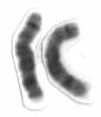| Chromosome 8 | |
|---|---|
 Human chromosome 8 pair after G-banding. One is from mother, one is from father. | |
 Chromosome 8 pair in human male karyogram. | |
| Features | |
| Length (bp) | 146,259,331 (CHM13) [1] |
| No. of genes | 646 (CCDS) [2] |
| Type | Autosome |
| Centromere position | Submetacentric [3] (45.2 Mbp [4] ) |
| Complete gene lists | |
| CCDS | Gene list |
| HGNC | Gene list |
| UniProt | Gene list |
| NCBI | Gene list |
| External map viewers | |
| Ensembl | Chromosome 8 |
| Entrez | Chromosome 8 |
| NCBI | Chromosome 8 |
| UCSC | Chromosome 8 |
| Full DNA sequences | |
| RefSeq | NC_000008 (FASTA) |
| GenBank | CM000670 (FASTA) |
Chromosome 8 is one of the 23 pairs of chromosomes in humans. People normally have two copies of this chromosome. Chromosome 8 spans about 146 million base pairs (the building material of DNA) and represents between 4.5 and 5.0% of the total DNA in cells. [5]
Contents
About 8% of its genes are involved in brain development and function, and about 16% are involved in cancer. A unique feature of 8p is a region of about 15 megabases that appears to have a high mutation rate. This region shows a significant divergence between human and chimpanzee, suggesting that its high mutation rates have contributed to the evolution of the human brain. [5]

